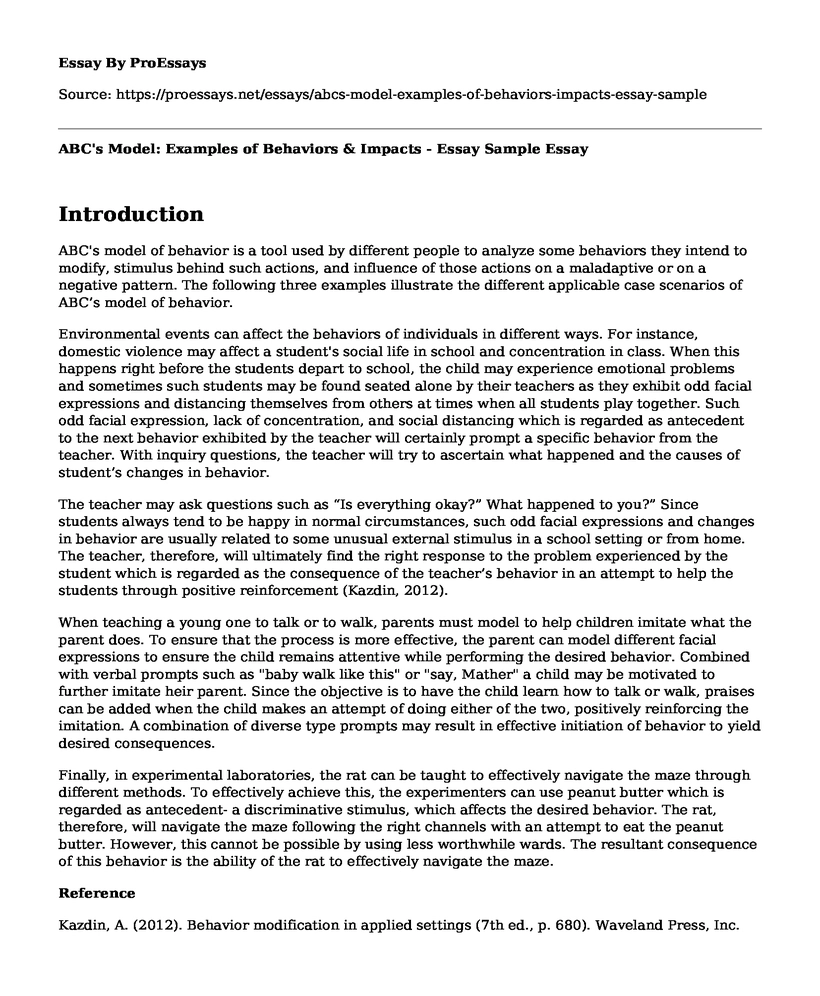Introduction
ABC's model of behavior is a tool used by different people to analyze some behaviors they intend to modify, stimulus behind such actions, and influence of those actions on a maladaptive or on a negative pattern. The following three examples illustrate the different applicable case scenarios of ABC’s model of behavior.
Environmental events can affect the behaviors of individuals in different ways. For instance, domestic violence may affect a student's social life in school and concentration in class. When this happens right before the students depart to school, the child may experience emotional problems and sometimes such students may be found seated alone by their teachers as they exhibit odd facial expressions and distancing themselves from others at times when all students play together. Such odd facial expression, lack of concentration, and social distancing which is regarded as antecedent to the next behavior exhibited by the teacher will certainly prompt a specific behavior from the teacher. With inquiry questions, the teacher will try to ascertain what happened and the causes of student’s changes in behavior.
The teacher may ask questions such as “Is everything okay?” What happened to you?” Since students always tend to be happy in normal circumstances, such odd facial expressions and changes in behavior are usually related to some unusual external stimulus in a school setting or from home. The teacher, therefore, will ultimately find the right response to the problem experienced by the student which is regarded as the consequence of the teacher’s behavior in an attempt to help the students through positive reinforcement (Kazdin, 2012).
When teaching a young one to talk or to walk, parents must model to help children imitate what the parent does. To ensure that the process is more effective, the parent can model different facial expressions to ensure the child remains attentive while performing the desired behavior. Combined with verbal prompts such as "baby walk like this" or "say, Mather" a child may be motivated to further imitate heir parent. Since the objective is to have the child learn how to talk or walk, praises can be added when the child makes an attempt of doing either of the two, positively reinforcing the imitation. A combination of diverse type prompts may result in effective initiation of behavior to yield desired consequences.
Finally, in experimental laboratories, the rat can be taught to effectively navigate the maze through different methods. To effectively achieve this, the experimenters can use peanut butter which is regarded as antecedent- a discriminative stimulus, which affects the desired behavior. The rat, therefore, will navigate the maze following the right channels with an attempt to eat the peanut butter. However, this cannot be possible by using less worthwhile wards. The resultant consequence of this behavior is the ability of the rat to effectively navigate the maze.
Reference
Kazdin, A. (2012). Behavior modification in applied settings (7th ed., p. 680). Waveland Press, Inc.
Cite this page
ABC's Model: Examples of Behaviors & Impacts - Essay Sample. (2023, Aug 13). Retrieved from https://proessays.net/essays/abcs-model-examples-of-behaviors-impacts-essay-sample
If you are the original author of this essay and no longer wish to have it published on the ProEssays website, please click below to request its removal:
- Research Paper on Schizophrenia: A Psychological Disorder
- ADHD Prevalence: Higher in Some Countries Than Others - Essay Sample
- Essay Sample on Exercise Effectiveness for ADHD: Analysis of Symptoms in Children/Adolescents
- ABA: Helping Autistic Kids Develop Social Skills - Essay Sample
- Developing Emotional Intelligence for Managers & Employees - Essay Sample
- Paper Sample on Bruce Stress Test Protocol: Answers Revealed
- Stress and Resilience in the Work Place - Essay Sample







